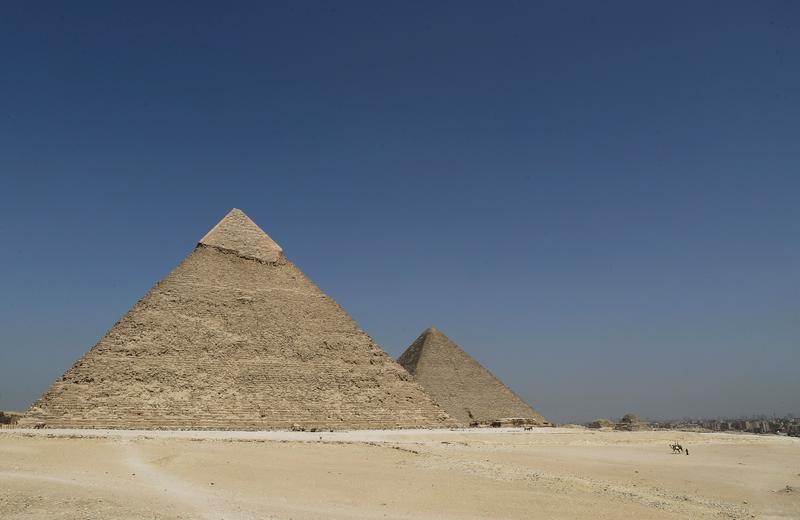What’s Inside the Great Pyramid of Giza?
By | April 30, 2019

Of the Seven Wonders of the Ancient World, the only one that still exists today is the Great Pyramid of Giza. The pyramid was built as a tomb for the pharaoh Khufu (also called Cheops) during his reign from 2589 to 2566 BC. The pharaoh wanted his pyramid to be greater than any other. He succeeded beyond all expectations in scale, mystery, and awe.
The Great Pyramid is comprised of over 2.3 million individual limestone blocks, which weigh an average of 2.5 tons each. The Great Pyramid stands just over 455 feet or about 45 stories high, although it is notable that over the course of millennia, the structure has eroded almost 20 feet. In fact, the Great Pyramid was the tallest man-made structure from the time of its construction until the 14th century A.D.
As impressive as the outside of the Pyramid may be, the secrets of its interior architecture are just as fascinating with new mysteries constantly being discovered.

Main Entrance
The Main Entrance to the Great Pyramid is blocked up on the north face of the structure. In fact, it was hidden until 820 A.D. when the caliph Abdullah Al Mamun used men to bore into the structure, creating the Robber’s Tunnel. While they were excavating, they found the true entrance. It is through the Robber’s Tunnel that tourists enter the pyramid today. After a horizontal journey of approximately 90 feet, it finds the original interior passageways.

The Ascending and Descending Passages
The difference between the newer Robber’s Tunnel with the original construction is striking. While the Al Mamun’s tunnel is rough-hewn, the original passageways crafted by the Egyptians are smooth, arrow-straight, and mathematically precise.
There are two primary passages in Khufu’s pyramid. The Descending Passage or Corridor, which is only 3.1 x 3.4 feet slopes down from the original entrance at just over 26 degrees and the Ascending Passage which heads upward into the middle structure of pyramid at the same exact angle.

The Subterranean Chamber
The Descending Passage heads for almost 300 feet under the Pyramid and into the bedrock. At the end of this passage, there is a strange subterranean chamber. This part of the pyramid seems to be unfinished with a dead end tunnel in the south. There is speculation about the purpose of this unfinished chamber. The most reasonable explanation is that this was meant to be the original tomb for Khufu but it was moved.

The Middle or Queen’s Chamber
The Ascending Passage was originally blocked up by limestone plugs, and it is supposed that it was unknown in antiquity. But the most interesting parts of the Great Pyramid are found up the Ascending Passage.
The first is the Queen’s Chamber, which is a misnomer given to it by earlier explorers. The Chamber is almost square at 8 feet, 10 inches by 17 feet, 2 inches by 15 feet high with a gabled ceiling. Don’t expect hieroglyphics here. The walls are bare although a niche exists where a statue may have been put. Most curious about the room are two narrow shafts that were originally bricked up and only discovered in 1872. The purpose of these shafts are uncertain – they may have been for ventilation or served some astronomical function. These shafts were explored by robotic probes and found they dead-ended into small “doors” with an unknown function. Researchers are still trying to figure them out.

The Grand Gallery
At the intersection where the Ascending Passage levels to the Queen’s Chamber the passage breaks off and upwards to the Grand Gallery. This narrow chamber is 28 feet high and 153 feet long and has a long gutter running through the center. Despite its name, it is likely the chamber was used to hold blocks that plugged the Ascending Passage. At the far end of the chamber were slots that probably were meant to hold portcullises.

The Upper or King’s Chamber
At the end of the Grand Gallery, there is the King’s Chamber. This rectangular chamber has a gabled roof and is clad in granite. It is devoid of any object except a broken, unfinished sarcophagus. It is possible that no mummy or treasure ever rested here. Curiously, the sarcophagus is larger than the ascending passage which means that was placed in the Chamber before the roof was put atop it. It also seems to be unfinished, which is curious considering that sarcophagi in other pyramids are much more elaborate. The roof of the chamber is also interesting since it contains five compartments known as “Relieving Chambers.” These were put there apparently to help disperse the immense weight of the structure above it.
Curious also are the two ventilation shafts which mirror those of the Queen’s Chamber, except that these find the exterior. Again, these may have been built for spiritual or astronomical purposes, or merely to give workers in the interior fresh air.

The Secret of the Void
New secrets keep on coming from the Great Pyramid. Researchers from the ScanPyramids project in 2017 have discovered a void in the pyramid using a scanner that employs muons. Other methods have corroborated its existence. While determining what the void or chamber is, researchers speculate that it may have been created to lessen the weight above the other chambers. The dimensions of the “Big Void” is similar to that of the Grand Gallery.
What this new chamber of secrets may reveal, waits to be seen and further speculated upon.

